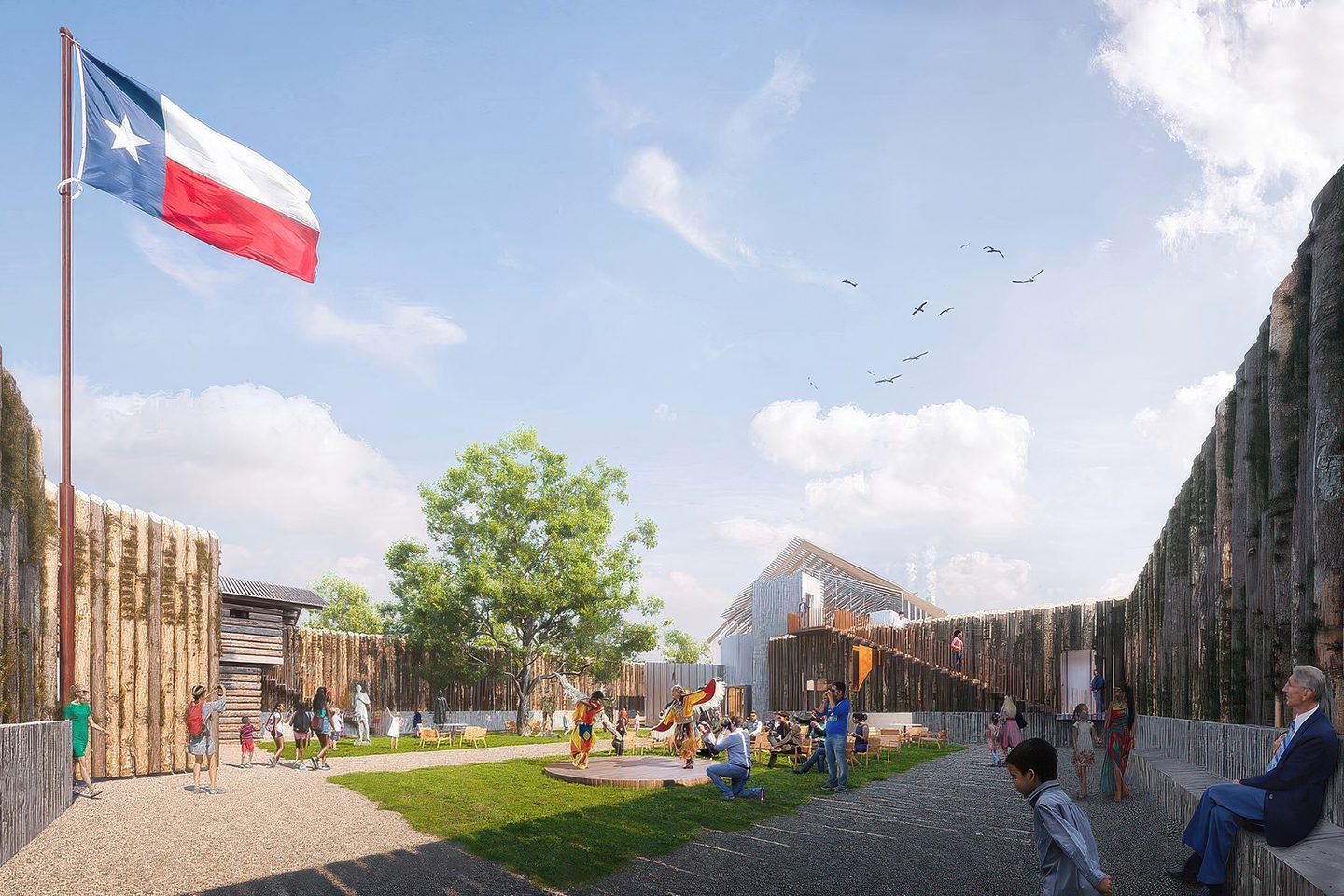Historic Site's New Owner Plans to Add Educational Facility
Fort Worth Star-Telegram, November 8, 2017

By Bill Hanna
ARLINGTON - To reach the oldest Anglo settlement in Tarrant County, you must first drive through one of it newest developments.
The 2,000-acre Viridian community in north Arlington is a bustling place, with new homes sprouting and earth movers turning dirt for future construction.
But in the middle of the development is a stand of trees that hides the site of the long-gone fort that marked the first organized settlement in what would become Tarrant County. In 1843, it hosted a treaty signing that helped open up North Texas to white settlers when Texas was an independent nation.
Today, it takes a four-wheel-drive vehicle to reach the site and there are plenty of chiggers and snakes to discourage trespassers from sticking around. Through the trees and underbrush lies Calloway Lake. Small and natural, it looks much the same as it did 175 years ago, with rickety pier that appears ready to collapse.
Bird's Fort, as the settlement was known, is not in danger of being lost to history. Instead, there's a plan to preserve it by the very development that's sprouting up around it.
Robert Kembel, president of The Nehemiah Co., which manages Viridian, purchased the property in August from the heirs of the Armentrout property, who had owned the land for the last century.
The plan is to keep the land intact and eventually add a cultural center or museum to educate residents about the significance of Bird's Fort.
"It's a very important piece of history for this region," Kembel said. "It's really the birthplace of North Texas being developed into the settlements we now have."
Kembel became enamored with saving the site the minute he first saw it. While nothing is left of the fort, the site remains unspoiled.
Only the base of an old windmill and part of a swimming pool foundation - both from the 20th century when a hunting and fishing club sat there - remain.
The Armentrout family, which had been approached by various developers and organizations over the years, was initially skeptical when Kembel laid out his vision.
"We had a watch-and-wait approach to it," said Lynn Armentrout Morris, the daughter of Charles Armentrout, who died in 2015.
In a 1997 Star-Telegram article, Charles Armentrout vowed to hold onto the land but added "after I'm no longer a member of society, there's no telling what might happen."
So Morris said the family's sole motivation was honoring her father's wishes. "His whole goal was to preserve the land in a natural state," she said by phone from her home in Georgetown.
As Viridian - which sits along North Collins Street 4 miles north of AT&T Stadium - began to emerge from the 2008 housing crisis, the family slowly became convinced of Kembel's plan.
"Over time, we saw their vision and it started making us realize it would be in the best interest to preserve the land and partner with them to make Daddy's dream come true," Morris said.
Rather than develop the site of the fort, Kembel worked to set up Arlington tax reinvestment zone number 6.
As Viridian builds out over the next eight to 10 years, the valuation of the property should help fund a cultural center or museum to educate the public about the site. When it's completed, Viridian plans to have about 4,200 residences. So far, it has more than 900.
TREATY SITE
For many who haven't grown up in the area, Bird's Fort is a forgotten piece of history.
After the Battle of Village Creek, not far from where Lake Arlington now stands, Gen. Edward H. Tarrant ordered Brevet Maj. Jonathan Bird to build a fort to protect the area against Indian raids.
Bird led volunteers from the 4th Brigade of the Texas Militia to the site where they built "a blockhouse and several smaller buildings enclosed in a picket stockade," according to the Handbook of Texas.
The fort's existence would be brief.
After a harsh winter, the fort was "apparently abandoned" in March 1842. Some inhabitants fled to the nearby Peters Colony, which covered a large swath of North Texas including parts of what would become Tarrant County. Others were lured east to what would become Dallas by its founder, John Neely Bryan.
But the fort had another significant role to play. Two years later, it became the site of a treaty between Native American tribes and the Republic of Texas.
On Sept. 29, 1843, 10 Native American tribes signed the Treaty of Bird's Fort, one of the few Indian treaties ratified by the Texas Senate. The tribes that agreed to the accord included the Delaware, Chickasaw, Waco, Tah-woc-cany, Keechi, Caddo, Ana-Dah-kah, Ionie, Biloxi and Cherokee.
"It was a treaty that said we can live peacefully together - we can recognize the indigenous population while at the same time encouraging new settlements," said Fort Worth historian Quentin McGown. "It was wishful thinking on President Houston's part."
The treaty, coupled with the Peters Colony, helped lure more settlers to North Texas.
"The treaty was one of a series of events that brought organized settlements to North Texas," McGown said. "I think the treaty anticipated people coming as a result of that Peters Colony contract."
Six years later, that other Tarrant County fort - Fort Worth - would be established at the confluence of the Clear Fork and West Fork of the Trinity River.
While it may have acknowledged some status for the local tribes, the treaty did not put Native American tribes on equal footing.
For white men, any crime against a Native American "shall be punished by the Government of Texas in the same manner as though the Indian were a white man." But the treaty said "if any Indian or Indians shall kill any white person, he or they shall suffer death."
The treaty also laid out a boundary line between the tribal land and white settlers where trading posts could be established.
The first was built at Founders Park in Arlington in 1845. Col. Middleton Tate Johnson set up the nearby Texas Rangers post the next year. From that post came Johnson Station, which became Arlington.
MARKING HISTORY
The land also had a colorful history during the 19th and 20th centuries. As far back as 1886, hunting and fishing clubs were established at the lake.
In 1917, Willis' grandfather E. W. Armentrout and three partners bought the 110 acres surrounding the lake and formed the Calloway Lakes Hunting and Fishing Club. In 1936, a historic marker was placed at the site for the Texas centennial.
In 1984, Duane Gage, then chairman of the Tarrant County Historical Commission, wrote a guest article in the Star-Telegram that detailed the efforts to honor the site's significance.
"In the 1930s, local historians became interested in the historic site and arranged to have an official Texas centennial marker placed at the edge of the sportmen's swimming pool, where it was believed the old blockhouse had stood, the swimming pool having been constructed supposedly where the fort's trenches had been located," he wrote.
In 1939, E. W. Armentrout bought out his partners and changed the name to the Silver Lake Hunting and Fishing Club.
"For 100 years, the property has served as a retreat from the city, a place to fish, shoot skeet and hunt birds for our familv and friends," Morris said.
The Armentrout family eventually removed the granite historical marker and placed it in storage after the marker was vandalized by trespassers.
A newer state historical marker sits along a trail in River Legacy Parks about a mile from the site.
The plan is to place the granite marker back at the site once more development protects it from four-wheelers and trespassers.
Geraldine Mills, president of the Arlington Historical Society, wants that to happen quickly. "It needs to be returned to the site as soon as possible," she said.
UNSPOILED LAND
What will go in the cultural center?
That's still to be determined.
Besides history of the fort, Kembel hopes to add fossils from a nearby dig site. Both Mills and McGown would like to see the history of the Native Americans who lived there also included.
Part of the attraction will be the unspoiled state of the land.
"Standing on that site is probably similar to what it felt like standing there in 1841," McGown said. "We have so few places like that are still in a natural setting. You can understand what brought them there. It was moderately protected. It had plenty of water and ample game."
And while there may not be a fort, standing by Calloway Lake can help visitors imagine what it was like for the first settlers.
"It helps you understand what was going through somebody's mind when they were seeing it for the very first time," MeGown said. "It helps us strip off layers of subsequent development and let us get back to where we began.

